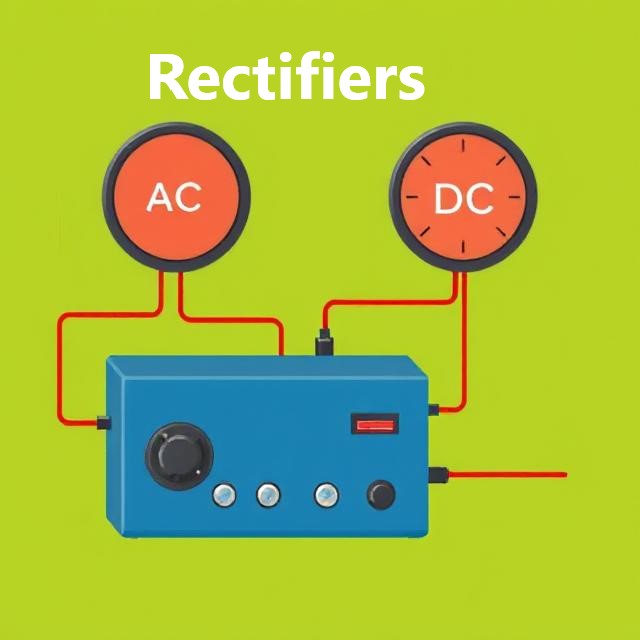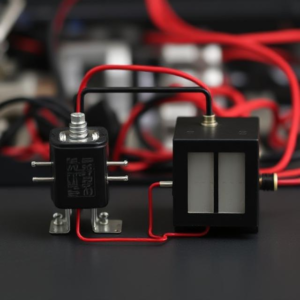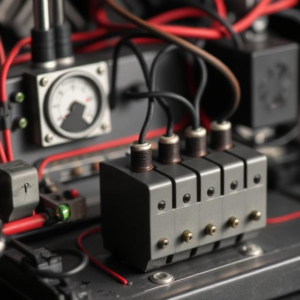A rectifier is an electronic device that converts alternating current (AC), which periodically changes direction, into direct current (DC), which flows in only one direction. This conversion is important because many electronic devices (like smartphones, computers, and radios) need DC power to operate, but most of the power available in homes and businesses is in the form of AC.

Simple Explanation:
- AC (Alternating Current): The type of electricity that comes from power outlets. The current alternates (changes direction) back and forth.
- DC (Direct Current): The type of electricity that flows in one direction. This is what most electronic devices use to work.
A rectifier makes the AC current into DC by allowing current to flow in one direction only (like a one-way valve for electricity). This is done using components like diodes.
How Does a Rectifier Work?
At its core, a rectifier works by using diodes, which are components that only allow current to flow in one direction.
1. Half-Wave Rectification:
In half-wave rectification, a single diode is used to convert AC into DC, but it only allows one half of the AC cycle to pass through.
- During the positive half of the AC cycle, the diode allows current to pass through.
- During the negative half of the AC cycle, the diode blocks the current, and no current flows.
So, with half-wave rectification, the output DC is pulsating (it only flows during the positive half of the AC cycle, and there’s no current during the negative half).
Example: Imagine a sine wave (which represents AC) — the diode lets through the positive peaks of the wave and blocks the negative peaks. This creates a pulsing DC signal.
2. Full-Wave Rectification:
In full-wave rectification, two or more diodes are used, and both halves of the AC waveform are converted to DC.
- The AC current is split into two halves. During the positive half of the AC cycle, one diode allows current to flow.
- During the negative half of the AC cycle, a second diode allows current to flow in the same direction, effectively “flipping” the negative half of the AC cycle so that it flows like a positive half.
The result is a smooth, pulsating DC with fewer gaps compared to half-wave rectification. Full-wave rectification is more efficient because it uses both halves of the AC cycle.
3. Bridge Rectifier:
A bridge rectifier is a specific type of full-wave rectifier that uses four diodes arranged in a bridge configuration. It’s often used in power supplies to provide smooth DC output.
- The bridge rectifier works the same way as the full-wave rectifier, but it’s more efficient and doesn’t require a center-tapped transformer.
- During both the positive and negative halves of the AC cycle, the diodes work together to allow current to flow in one direction only, converting the entire AC waveform into DC.
Why Do We Need Rectifiers?
- Conversion of AC to DC: Many devices (like computers, TVs, and radios) need DC power, but we usually get AC power from power outlets. A rectifier converts the AC into the DC that these devices need.
- Power Supplies: Rectifiers are commonly found in the power supplies of electronic devices. For example, a laptop charger uses a rectifier to turn the AC from the outlet into the DC that charges the laptop battery.
- Efficient Energy Use: Rectifiers help in making sure that electronic circuits work more efficiently by supplying the correct type of current.
Types of Rectifiers:
- Half-Wave Rectifier:
- Uses: Simple applications where smooth DC isn’t needed.
- Output: Pulsating DC (only positive half of the AC waveform).
- Efficiency: Low, because it only uses half of the AC cycle.
- Full-Wave Rectifier:
- Uses: Applications where smoother DC is needed.
- Output: Smooth, pulsating DC (both halves of the AC waveform are used).
- Efficiency: Higher than half-wave because it uses the entire AC cycle.
- Bridge Rectifier:
- Uses: Most common in power supplies where efficient and smooth DC is needed.
- Output: Smooth DC with the full AC cycle used.
- Efficiency: High, because it uses four diodes to ensure current always flows in the same direction.
Example of a Rectifier in Use:
Imagine a smartphone charger:
- The AC power from your wall outlet (which changes direction 50 or 60 times a second) is rectified by the charger’s rectifier.
- The rectifier converts the AC into DC, which is then used to charge your smartphone’s battery.
Key Points:
- Rectifiers convert AC to DC.
- They work by using diodes, which allow current to flow in only one direction.
- There are half-wave, full-wave, and bridge rectifiers, each offering different efficiencies and levels of smoothness for the DC output.
- Half-wave rectifiers are simple but less efficient, while full-wave and bridge rectifiers produce smoother and more efficient DC.
Summary:
A rectifier is a device that converts AC (alternating current) into DC (direct current). This is crucial for most electronic devices that require DC power. Rectifiers use diodes to allow current to flow in only one direction, and there are different types (half-wave, full-wave, and bridge) that offer various levels of efficiency and smoothness in the DC output.











